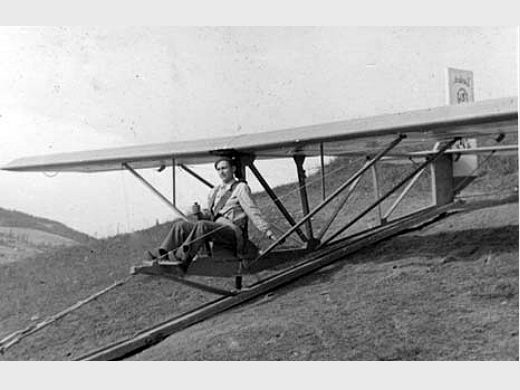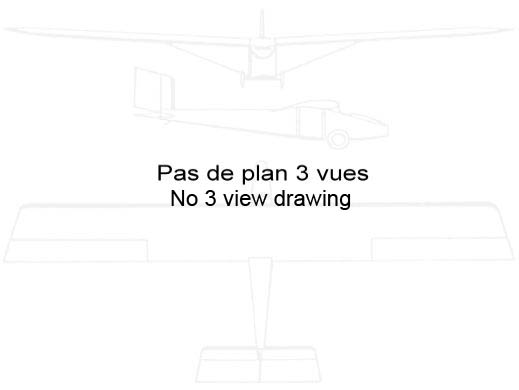
Czerwiński WWS-2 Żaba
| DONNÉES GÉNÉRALES |
| Année du premier vol (ou de design, si seul projet) |
1937 |
| Pays | Pologne |
| Designer(s) | CZERWIŃSKI, Wacław |
| Premier constructeur | |
| Type d'appareil | Planeur |
| Fonction | Initiation |
| SPÉCIFICATIONS TECHNIQUES |
| Envergure | 9.33 m |
| Longueur | 5.45 m |
| Hauteur | 1.65 m |
| Allongement | 6.3 |
| Surface alaire | 13.8 m2 |
| Profil aile | Göttingen 365 |
| Masse à vide | 85 kg |
| Masse maxi | 164 kg |
| Charge alaire | 11.9 kg/m2 |
| Vitesse mini | -- |
| Vitesse maxi | -- |
| Finesse maxi | 11 à 54 km/h |
| Taux de chute mini | 1.23 m/s à 45 km/h |
| Nb sièges | 1 |
| Structure | Bois et toile. |
AUTRES INFORMATIONS
| Constructeur(s) |
| ||||||
| Infos techniques | -- | ||||||
| Histoire résumée | Eine Konstruktion von Wacław Czerwiński. Der Schulgleiter entstand auf Basis des CWJ-bis "Skaut". Nach der ersten Serie wurden Verbesserungen vorgenommen die zur Bezeichnung "Żaba II" führten und noch spätere Verbesserungen im Jahre 1938 führten schließlich zur Bezeichnung "Żaba II bis". Die Veränderungen waren nicht groß, es wurde das Gewicht um 10 kg verringert und die Tragflächenenden wurden optimiert um einen besseren Kurvenflug zu erreichen. Es wurden über 150 Segler gebaut wovon nach Ausbruch des Krieges 2 Stück in die sowjetischen Hände fielen und einer in einem Versteck den Krieg überstand. Das Exemplar ist nach dem Krieg für Vergleichsflüge mit der IS-A "Salamandra" genutzt worden und 1950 ist er dem Luftfahrtmuseum in Krakow geschenkt worden. Czerwiński improved the design of the CWJ-bis, with reduced structure weight and changes to the flying control surfaces, to improve performance and manoeuverability. The W.W.S. 2 followed the primary trainer concept with a skeletal fuselage wire-braced to a simple fabric covered wing, supported by two struts each side, and tail unit. The completely open seating area followed the theory of the day, that called for the student pilot to feel the wind on his/her body to fully appreciate the movements of the aircraft in response to control movements and atmospheric changes, such as gusts, turbulence or thermals. One W.W.S. 2 survived the war, to fly again, and was retired to the Krakow Aviation Museum in 1950. Production of the Żaba at the W.W.S. Commenced in 1937, with 60-70 built before the outbreak of WWII. The Żaba II (Żaba-bis) was produced at the Lwow aviation workshops (L.W.L.), with approx 150 built, 20 for export. Variantes * WWS-2 Żaba – production aircraft from W.W.S. From 1937. * WWS-2-bis Żaba II – improved version with reduced weight and improved controls built by the Lwow Aviation Workshops (L.W.L.). * 'CWA Wren – A WWS-2 Żaba built in Canada, after WWII, by Wacław Czerwiński. | ||||||
| Liens personnalités | CZERWIŃSKI, Wacław (Pologne) | ||||||
| Remarques | Żaba = grenouille (= Frosch) | ||||||
| Exemplaires existants |
|
SOURCES DOCUMENTAIRES
| Liens WEB | Site : Site de Piotr Piechowski . Note + 10 photos + plan 3 vues + specs. (2009-11-01 CL) Site : Wikipedia : WWS-2 . Note + specs. (2010-01-22 CL) Site : Muzeum Lotnictwa Polskiego w Krakowie . Note + 1 photo + specs. (2010-01-22 CL) Site : UIUC Applied Aerodynamics Group . Göttingen 365 airfoil. (2010-02-07) Site : UIUC Applied Aerodynamics Group . Göttingen 365 fichier DAT. (2010-02-07) |
| Livres | Le planeur SA 103/SA 104 par RAVEL, Christian (2008) [p. 17. Plan]. Polskie konstrukcje lotnicze, Tom III par GLASS, Andrzej (2008) [p. 248. ]. Szybowce Wyczynowe Czerwińskiego par GLASS, Andrzej (2017) [p. 15. Photo]. |

Team J2mcL © 2003 -
- Pages optimisées pour Mozilla Firefox


